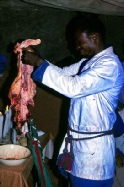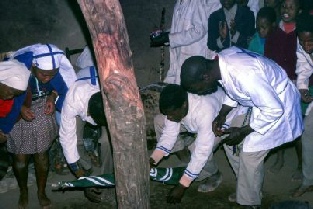© 2023 Dr Margaret Sheppard
Setlhabelo (pI. Ditlhabelo) (Sacrifice) Services
Sacrifice Services can be of many types and are based on the various sacrifices detailed in Leviticus. In each case they were made because the family holding the service was suffering from various problems and on asking for a special prophecy at their church had been told that such a service was necessary. The prophet had "seen" the type of sacrifice needed.
The churches that practise these services justify them by claiming that the burning of the sacrificial items pleases God, and hence the presence of Moya (the Spirit) is strengthened to allow those with the gift of prophecy to "see" and so analyse the problems of the family. (This is not unlike the philosophy of a traditional Badimo (Ancestral) feast which aims to gather the Badimo's (Ancestors’) attention around one family, thus all the food must be eaten in that home, and the left overs are buried and/or burnt in the yard.)
It appeared that a Setlhabelo Service is often held after other methods had failed. For example the family that held the Setlhabelo of unleavened bread had previously held a Ditapelo (Prayer Service), which although helping them, had not effected a complete cure. Data collected from the interview schedules suggested further evidence to support this, i.e. a recourse to remedies of increasing complexity -
Once a Sacrifice Service has been prophesied as necessary, preparations are made. If the family do not have a suitably large house, a temporary shelter of poles and tarpaulin is erected in their yard. Church members help with this and with the preparation of the sacrificial items and cooking the food to be eaten after the service.




This mother had been bewitched & a sacrifice was prophesied as necessary to cure her
Sacrificial cow is sprinkled with Holy Water by the Moruti before slaughter.
Family members touch the slaughtered beast, the Moruti prays touching the sacrifice with his prophecy pole whilst praying & sprinkling Holy Water
Members of the congregation preparing the feast to be eaten after sunrise, following the sacrifice service.
The Church organizing the service is the first to arrive, as a congregation. (When I went with B.U.C.Z., we collected at the Moruti's home at about 10.00 p.m. where a short service was held, then we walked through the village singing hymns. The Moruti walked at the back sprinkling our footsteps with protective Holy Water.)
Whilst awaiting for the arrival of the other invited congregations the service would start in the usual way and the host congregation would be reminded to be polite to the visitors. As each visiting church arrived, it would enter in the usual way, in a line behind its leader, starting a hymn outside which was taken up by those inside. After being formally welcomed, the visitors would move to their various positions (women together, Secretaries with Secretaries, Dikhosa with Dikhosa etc.)
When all the visitors had arrived the owner of the home would be called upon to explain the reason for the service and give his formal permission. Before continuing, the prophets would dance to "see" if it was possible to hold the service (comparable to a traditional doctor casting his bones to ensure it is safe to continue).














Different congregations arriving from various invited churches. They start a hymn outside, are admitted by the Khosa, who directs them to their places -
Women together
Entering behind their Moruti



Bowing respectfully as a new congregation enters
Men and boys together
Secretaries together
Next as a Secretary read from Numbers 8, v. 1-








More packets of candles would be opened, lit and distributed to the church choirs who would lead the congregation outside to the sacrificial fire that had been lit by the Dikhosa. The family would sit in a semi-
The family sitting in a semi circle near the fire, surrounded by the congregations. The Church choirs are holding the candles
The sacrificial fire
Next, while the congregation sang, clapped and drummed hymns, the sacrifice would be made. Usually this was conducted by two or three Baruti, whilst the prophets danced around the fire and the family. Usually only experienced prophets danced, clutching their prophecy poles. Those who could not control the Spirit or who were impure were advised not to dance because of the "power" of the sacrificial fire -
Before each item was .sacrificed, the family was liberally sprinkled by the sacrificers with Holy Water from a bucket, the item (cow liver, kidneys, bottle of oil, cakes etc.) was raised three times and thrown into the fire. After all the items had been burnt, the candles were collected in bundles and thrown on as well. Any remaining Holy Water was added too
Hymn singing continued until the prophets started to receive Moya (the Spirit). They were called upon one at a time to reveal their prophecies. The singing was stopped for this, although the prophets often walked briskly around the fire. Some would be whistling, another twirled a string, and several appeared to have private conversations with Moya. For example they would say words such as "Wareng, Moya?" (What are you saying, Spirit?"); or they used non-
The subject matter of the prophecies was very similar to the divinations of traditional doctors, typically physical symptoms, were described -





















Those with the gift of prophecy joined the dancing around the sacrificial fire whilst the rest of the congregations sang the hymns and clapped . This is all to call Moya -
Some of the less experienced prophets are unable to control possession by Moya and other more experienced prophets ensure they do not come to harm e.g. falling into the sacrificial fire (I observed this at one Sethlabelo Service)




Moruti beating the drum to call Moya
An experienced prophet ensuring safety of new and inexperienced prophet
One of the duties of a Khosa is supervising the pots where sacrificed beast is cooking



After prophecies had been given the family were prayed upon by the prophets and/or Barapedi. At one service each family member had to hold first their hands, then the soles of their feet over the smoke of the dying sacrificial fire. (This appears to be similar to some traditional remedies where patients may bathe in the smoke of burning herbal remedies.) If prophecies had revealed the location of any buried sorcery and powerful specialists were present, it would be dug out.
Prophets revealing the prophecies shown to them by Moya to the family. They all had their individual method of delivery



Family “bathing” in the protective smoke from the embers of the sacrificial fire
The service might then return inside or continue outside in the lolwapa. Prophesying would continue and if there was time individuals requesting prophecies would be attended to.
At the conclusion of the service after sunrise, a meal would be served to all. This would consist of the non-
More details of these services , the prophecies and outcomes follow in the next three sub sections -
Prophets dance around the fire whilst rest of congregation sing hymns and clap. This helps to “call the Spirit” to the Prophets to analyse the cause & resolution of the famuly’s problems